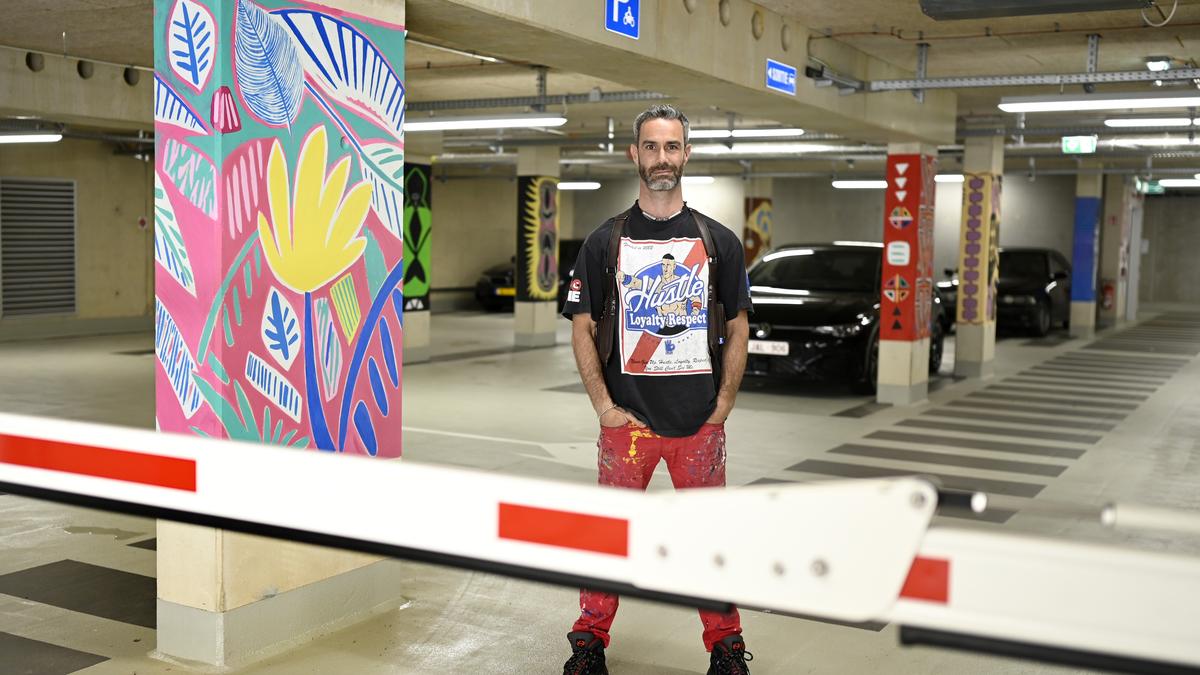An underground school car park is not exactly where you would expect to find colourful paintings, but in Rue du Lavoir in Leudelange, French painter Victor Tricar is using concrete as his canvas.
Tricar has lived in the Grand Duchy for eight years and is a member of the Hariko collective. “I approached the Leudelange municipality a year ago with the idea of creating a fresco in the passageway leading from the car park to the school, as well as painting four pillars,” said the artist, who also sits on the municipality’s cultural committee.
The artist has created a huge fresco in the passageway leading from the car park to the school © Photo credit: Chris Karaba
After submitting his sketches to the local authority, the painter set about creating his work. “Once the fresco and the four posts had been completed, the local authority finally gave me carte blanche to decorate all 27 pillars, because it was a bit sad to see the rest of the car park remain grey,” he said.
Splahes of colour
The artist wasted no time. Armed with his brushes and pots of acrylic, he transformed each post into a veritable work of art, inspired by mythical and tropical forests. “My idea was to bring joy and colourful breaths of fresh air, a bit of happiness and good humour to make this place a bit more fun for children and their families,” he said.
The real place for art is wherever you least expect it, and that’s where it’s most needed
Victor Tricar
Painter
Tricar spent long hours in the underground space in Leudelange. “If I start early enough in the morning and stay working until midnight or one o’clock in the morning, I can produce a pillar in a day,” he said.
This daily routine sees him cross paths with the car park’s users, mostly parents who are taking their young children to school. “The kids come up to me when I’m painting, ask me questions, there’s always something going on,” he said.
Making art accessible
In his underground works, the artist has infused a wide range of inspirations drawn from his many travels. Tropical colours and tribal motifs intermingle. “As an artist who has travelled a lot, I’m a real emotional sponge. I’ve brought back all these colours from my travels, particularly in Central America, to pour them onto these walls,” Tricar said.
While Tricar paints, traffic at the car park continues © Photo credit: Chris Karaba
And that’s what this project is all about: making art accessible to as many people as possible. “The real place for art is in places where we least expect it, and that’s where it’s most needed. That’s why street art is so successful, because it meets a need. It’s not just a fashion phenomenon, street art does good,” he said.
“I used to chase after galleries to exhibit my paintings,” said Tricar. He has since abandoned what he called an elitist vision of art, using tarpaulins and other surfaces instead of traditional canvas.
Each pillar features a unique motif © Photo credit: Chris Karaba
The artist has created several frescoes in the car park © Photo credit: Chris Karaba
Victor Tricar draws his inspiration from his travels © Photo credit: Chris Karaba
The painter has retained his technique from those days. Unlike other street artists, Victor Tricar doesn’t use spray paint. “I do all my work in acrylic, using brushes and my fingers,” he said.
Users delighted
The artist created his first underground fresco in 2024, on level -3 of the Cloche d’Or shopping centre’s car park. After Leudelange, he would like to continue the adventure. “I’d like to take over Luxembourg’s car parks, bringing colour to places that lack it and are overwhelming in every way. My aim is to make a positive impact on the urban landscape and do something good for passers-by.”
Drivers at the Rue du Lavoir car park have already been won over, like Fred Robino, who is a chef at the daycare centre attached to the school. “This project is sensational. We’re used to car parks that are a bit gloomy, but here, the paintings bring the place to life and make you want to walk around. Every day we discover something new, a detail, a colour,” he said.
Of the 27 pillars, four are still waiting to be completed. Tricar estimates that he will have completed the project by the end of July. In September, the car park and school will have their inauguration ceremonies. The artist’s work will then be available to as many people as possible. “And then, if cars scratch the frescoes over the years, too bad! That’s the life of the work.”
(This story was first published in Virgule. Translated using AI, edited by Cordula Schnuer.)
